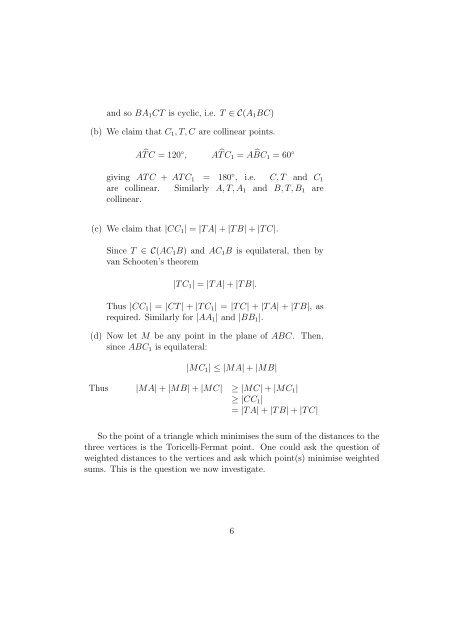2. Equilateral Triangles
2. Equilateral Triangles
2. Equilateral Triangles
You also want an ePaper? Increase the reach of your titles
YUMPU automatically turns print PDFs into web optimized ePapers that Google loves.
and so BA1CT is cyclic, i.e. T ∈ C(A1BC)<br />
(b) We claim that C1, T, C are collinear points.<br />
A T C = 120 ◦ , A T C1 = A BC1 = 60 ◦<br />
giving AT C + AT C1 = 180 ◦ , i.e. C, T and C1<br />
are collinear. Similarly A, T, A1 and B, T, B1 are<br />
collinear.<br />
(c) We claim that |CC1| = |T A| + |T B| + |T C|.<br />
Since T ∈ C(AC1B) and AC1B is equilateral, then by<br />
van Schooten’s theorem<br />
|T C1| = |T A| + |T B|.<br />
Thus |CC1| = |CT | + |T C1| = |T C| + |T A| + |T B|, as<br />
required. Similarly for |AA1| and |BB1|.<br />
(d) Now let M be any point in the plane of ABC. Then,<br />
since ABC1 is equilateral:<br />
|MC1| ≤ |MA| + |MB|<br />
Thus |MA| + |MB| + |MC| ≥ |MC| + |MC1|<br />
≥ |CC1|<br />
= |T A| + |T B| + |T C|<br />
So the point of a triangle which minimises the sum of the distances to the<br />
three vertices is the Toricelli-Fermat point. One could ask the question of<br />
weighted distances to the vertices and ask which point(s) minimise weighted<br />
sums. This is the question we now investigate.<br />
6

















